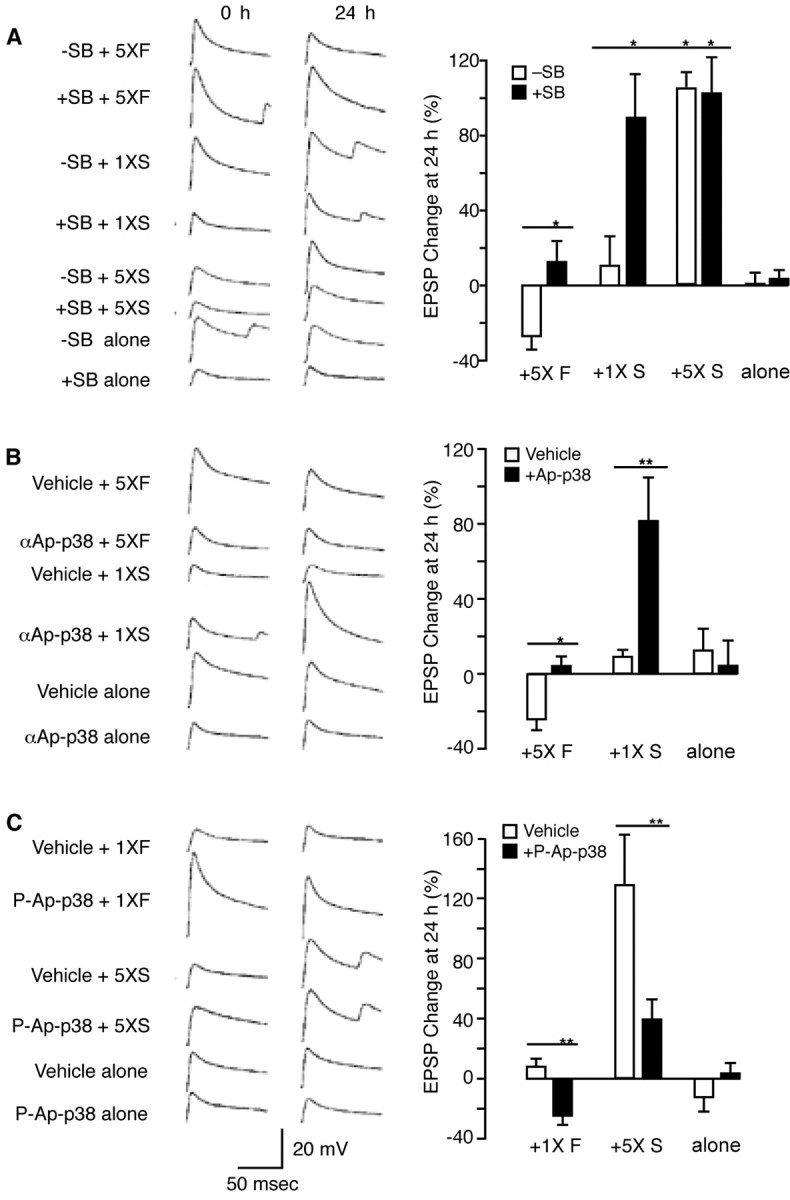Figure 5.

Bidirectional function of p38 kinase. A, SB 203580 blocked long-term depression and enhanced long-term facilitation: representative examples of EPSP traces before and 24 hr after treatment, and summary data. To induce long-term depression, the sensory-to-motor neuron cocultures were treated with five 5 min pulses of 1 μm FMRFa (5× F), which resulted in depressed EPSPs at 24 hr (-26.8 ± 6.6%; n = 12). This long-term depression was blocked by incubation with SB 203580 (3 μm) 30 min before and throughout the treatment with FMRFa (5×F+ SB; 12.6 ± 10.8%; n = 10; p < 0.05). For long-term facilitation, the cells were treated with five 5 min pulses or a single 5 min pulse of 5-HT (10 μm). A single pulse of 5-HT (1× S) had no long-term effect (10.6 ± 15.3%; n = 7), but long-term facilitation was established in cells preincubated with the inhibitor (3 μm, 30 min) and then treated with one pulse of 5-HT (1× S + SB; 88.9 ± 22.5; n = 10; p < 0.01). The long-term facilitation produced in this way was comparable with that resulting from five pulses of 5-HT (5× S; 103.5 ± 7.5%; n = 8). Five pulses of 5-HT in cells incubated in 3 μm SB 203580 (5× S + SB) did not enhance the long-term facilitation further (102.2 ± 18.7%; n = 7). Cells treated with the inhibitor alone (SB alone; 3.1 ± 4.7%; n = 11) had no long-term effect. B, Injection of Ap-p38 antibody blocked long-term depression and enhanced long-term facilitation: EPSP traces and summary data. The inactivating antibody against Ap-p38 kinase (Fig. 2) was injected into pleural sensory neurons before treatment with FMRFa or 5-HT. Five 5 min pulses of FMRFa coupled with injection of the vehicle (0.4 m potassium acetate and 10 mm Tris-HCl, pH 7.4) (5× F + vehicle) induced long-term depression at 24 hr (-24.2 ± 5.4%; n = 13); the long-term depression was blocked by injecting the antibody (5× F +αAp-p38; 3.3 ± 10.9%; n = 9; p < 0.05). A single pulse of 5-HT coupled with injection of the vehicle (1× S + vehicle) had no long-term effect (8.9 ± 3.7%; n = 14) but produced long-term facilitation after the Ap-p38 antibody was injected (1× S +αAp-p38; 81.2 ± 22.2%; n = 7; p < 0.01). No effect on the EPSP at 24 hr was observed with the injection of vehicle alone (12.5 ± 11.2%; n = 4) or antibody alone (4.1 ± 13.3%; n = 7). C, Injection of activated Ap-p38 kinase enhanced long-term depression and blocked long-term facilitation: EPSP traces and summary data. A single pulse of FMRFa coupled with the injection of vehicle (1× F + vehicle) had no long-term effect (7.6 ± 5.2%; n = 8). Injection of phospho-Ap-p38 kinase into sensory neurons coupled with a single pulse of FMRFa (1×F + p-Ap-p38) induced long-term depression (-24.6 ± 5.91%; n = 11; p < 0.01). Five pulses of 5-HT coupled with injection of vehicle (5× S + vehicle) induced long-term facilitation (127.5 ± 29.7%; n = 13); long-term facilitation was blocked by injecting phospho-Ap-p38 kinase (5× S + p-Ap-p38; 38.3 ± 12.5; n = 13%; p < 0.01). No effect at 24 hr was observed with injection of vehicle alone (-12.3 ± 9.2%; n = 6) or injection of phospho-Ap-p38 kinase alone (3.3 ± 6.8%; n = 12). Data were analyzed by ANOVA. Histograms show percentage changes in the mean (±SE) of EPSP amplitudes 24 hr after the treatment.
